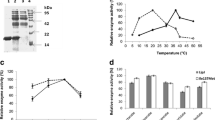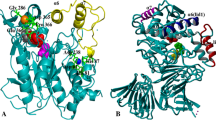Abstract
Biocatalysts are intrinsically reactive and hence their operational stability is of vital significance for any bioprocess. The setback in biocatalyst stability has been tackled from diverse prospects. Inherently, stable biocatalysts are markedly realized and a regular attempt is being made to seek out new organisms that harbor them. Here, we analyzed the industrial biocatalyst lipase A (Native) of Bacillus subtilis and its six thermostable mutants (2M, 3M, 4M, 6M, 9M and 12M) computationally using conformational sampling technique. Consequently, the various structural events deciphering thermostability like root mean square deviation, root mean square fluctuation, radius of gyration and polar surface area showed mutant 12M to be highly stable with statistical validation. Besides, static model analysis involving intra-molecular interactions, secondary structure, solvent accessibility, hydrogen bond pattern, simulated thermal denaturation and desolvation energy also supported 12M comparatively. Of note, the presence of high secondary structural rigidity and hydrogen bonds increased thermostability and functionality of 12M, thus selecting it as a best template for designing thermostable lipases in future. Also, this study has a significant implication toward a better understanding of conformational sampling in enzyme catalysis and enzyme engineering.
Similar content being viewed by others
References
Acharya P, Rajakumara E, Sankaranarayanan R, Rao N M (2004). Structural basis of selection and thermostability of laboratory evolved Bacillus subtilis lipase. J Mol Biol, 341(5): 1271–1281
Ahmad S, Kamal M Z, Sankaranarayanan R, Rao N M (2008). Thermostable Bacillus subtilis lipases: in vitro evolution and structural insight. J Mol Biol, 381(2): 324–340
Ahmed A, Rippmann F, Barnickel G, Gohlke H (2011). A normal modebased geometric simulation approach for exploring biologically relevant conformational transitions in proteins. J Chem Inf Model, 51 (7): 1604–1622
Annenkov G A, Klepikov N N, Martynova L P, Puzanov V A (2004). Wide range of the use of natural lipases and esterases to inhibit Mycobacterium tuberculosis. Probl Tuberk Bolezn Legk, (6): 52–56
Bandyopadhyay S, Chakraborty S, Bagchi B (2005). Secondary structure sensitivity of hydrogen bond lifetime dynamics in the protein hydration layer. J Am Chem Soc, 127(47): 16660–16667
Berman H M, Westbrook J, Feng Z, Gilliland G, Bhat T N, Weissig H, Shindyalov I N, Bourne P E (2000). The Protein Data Bank. Nucleic Acids Res, 28(1): 235–242
Bikadi Z, Demko L, Hazai E (2007). Functional and structural characterization of a protein based on analysis of its hydrogen bonding network by hydrogen bonding plot. Arch Biochem Biophys, 461(2): 225–234
Bruins M E, Janssen A E, Boom R M (2001). Thermozymes and their applications: a review of recent literature and patents. Appl Biochem Biotechnol, 90(2): 155–186
Cavallo L, Kleinjung J, Fraternali F (2003). POPS: A fast algorithm for solvent accessible surface areas at atomic and residue level. Nucleic Acids Res, 31(13): 3364–3366
Chou C C, Rajasekaran M, Chen C (2010). An effective approach for generating a three-Cys2His2 zinc-finger-DNA complex model by docking. BMC Bioinformatics, 11(1): 334
Cossio P, Granata D, Laio A, Seno F, Trovato A (2012). A simple and efficient statistical potential for scoring ensembles of protein structures. Sci Rep, 2(14):Available at: http://www.nature.com/doifinder/10.1038/srep00351
Duhovny D, Nussinov R, Wolfson H J (2002). Efficient unbound docking of rigid molecules. In Algorithms in bioinformatics. Springer, pp. 185–200
Eggert T, van Pouderoyen G, Dijkstra B W, Jaeger K E (2001). Lipolytic enzymes LipA and LipB from Bacillus subtilis differ in regulation of gene expression, biochemical properties, and three-dimensional structure. FEBS Lett, 502(3): 89–92
Feldblum E S, Arkin I T (2014). Strength of a bifurcated H bond. Proc Natl Acad Sci USA, 111(11): 4085–4090
Fersht A R, Bycroft M, Horovitz A, Kellis J T, Matouschek A, Serrano L (1991). Pathway and stability of protein folding. Philos Trans R Soc Lond B Biol Sci, 332(1263): 171–176
Gaillard P, Carrupt P A, Testa B, Boudon A (1994). Molecular lipophilicity potential, a tool in 3D QSAR: method and applications. J Comput Aided Mol Des, 8(2): 83–96
Gasteiger J, Rudolph C, Sadowski J (1990). Automatic generation of 3D-atomic coordinates for organic molecules. Tetrahedron Comput. Methodol., 3(6): 537–547
Goodenough P W, Jenkins J A (1991). Protein engineering to change thermal stability for food enzymes. Biochem Soc Trans, 19(3): 655–662
Gupta R, Gupta N, Rathi P (2004). Bacterial lipases: an overview of production, purification and biochemical properties. Appl Microbiol Biotechnol, 64(6): 763–781
Hasan F, Shah A A, Hameed A (2006). Industrial applications of microbial lipases. Enzyme Microb Technol, 39(2): 235–251
Heinig M, Frishman D (2004). STRIDE: a web server for secondary structure assignment from known atomic coordinates of proteins. Nucleic Acids Res, 32(Web Server issue): W500–2
Houde A, Kademi A, Leblanc D (2004). Lipases and their industrial applications: an overview. Appl Biochem Biotechnol, 118(1–3): 155–170
Ito S, Kobayashi T, Ara K, Ozaki K, Kawai S, Hatada Y (1998). Alkaline detergent enzymes from alkaliphiles: enzymatic properties, genetics, and structures. Extremophiles, 2(3): 185–190
Jaeger K E, Reetz M T (1998). Microbial lipases form versatile tools for biotechnology. Trends Biotechnol, 16(9): 396–403
Jamroz M, Kolinski A, Kmiecik S (2013). CABS-flex: Server for fast simulation of protein structure fluctuations. Nucleic Acids Res, 41 (Web Server issue): W427–31
Ji X L, Liu S Q (2011). Is stoichiometry-driven protein folding getting out of thermodynamic control? J Biomol Struct Dyn, 28(4): 621–623, discussion 669–674
Kamal M Z, Ahmad S, Molugu T R, Vijayalakshmi A, Deshmukh M V, Sankaranarayanan R, Rao N M (2011). In vitro evolved nonaggregating and thermostable lipase: structural and thermodynamic investigation. J Mol Biol, 413(3): 726–741
Keating K S, Flores S C, Gerstein M B, Kuhn L A (2009). StoneHinge: hinge prediction by network analysis of individual protein structures. Protein Sci, 18(2): 359–371
Klibanov A M (1990). Asymmetric transformations catalyzed by enzymes in organic solvents. Acc Chem Res, 23(4): 114–120
Klibanov A M (1997). Why are enzymes less active in organic solvents than in water? Trends Biotechnol, 15(3): 97–101
Krüger D M, Ahmed A, Gohlke H (2012). NMSim web server: integrated approach for normal mode-based geometric simulations of biologically relevant conformational transitions in proteins. Nucleic Acids Res, 40(Web Server issue): W310–6
Kruskal W H (1952). A nonparametric test for the several sample problem. Ann Math Stat, 23(4): 525–540
Kynclova E, Hartig A, Schalkhammer T (1995). Oligonucleotide labelled lipase as a new sensitive hybridization probe and its use in bio-assays and biosensors. J Mol Recognit, 8(1–2): 139–145
Larios A, García H S, Oliart R M, Valerio-Alfaro G (2004). Synthesis of flavor and fragrance esters using Candida antarctica lipase. Appl Microbiol Biotechnol, 65(4): 373–376
Linko Y Y, Lämsä M, Wu X, Uosukainen E, Seppälä J, Linko P (1998). Biodegradable products by lipase biocatalysis. J Biotechnol, 66(1): 41–50
Lobanov M Y, Bogatyreva N S, Galzitskaya O V (2008). Radius of gyration as an indicator of protein structure compactness. Mol Biol, 42(4): 623–628
Lou Y C, Wang I, Rajasekaran M, Kao Y F, Ho MR, Hsu S T D, Chou S H, Wu S H, Chen C (2014). Solution structure and tandem DNA recognition of the C-terminal effector domain of PmrA from Klebsiella pneumoniae. Nucleic Acids Res, 42(6): 4080–4093
Lou Y C, Wei S Y, Rajasekaran M, Chou C C, Hsu H M, Tai J H, Chen C (2009). NMR structural analysis of DNA recognition by a novel Myb1 DNA-binding domain in the protozoan parasite Trichomonas vaginalis. Nucleic Acids Res, 37(7): 2381–2394
Luo S C, Lou Y C, Rajasekaran M, Chang Y W, Hsiao C D, Chen C (2013). Structural basis of a physical blockage mechanism for the interaction of response regulator PmrA with connector protein PmrD from Klebsiella pneumoniae. J Biol Chem, 288(35): 25551–25561
Ma J, Zhang Z, Wang B, Kong X, Wang Y, Cao S, Feng Y (2006). Overexpression and characterization of a lipase from Bacillus subtilis. Protein Expr Purif, 45(1): 22–29
Mahalingam R, Peng H P, Yang A S (2014). Prediction of fatty acidbinding residues on protein surfaces with three-dimensional probability distributions of interacting atoms. Biophys Chem, 192: 10–19
Mahalingam R, Peng H P, Yang A S (2014). Prediction of FMN-binding residues with three-dimensional probability distributions of interacting atoms on protein surfaces. J Theor Biol, 343: 154–161
Munoz A, Katerndahl D A (2000). Diagnosis and management of acute pancreatitis. Am Fam Physician, 62(1): 164–174
Noureddini H, Gao X, Philkana R S (2005). Immobilized Pseudomonas cepacia lipase for biodiesel fuel production from soybean oil. Bioresour Technol, 96(7): 769–777
Pace C N, Fu H, Fryar K L, Landua J, Trevino S R, Shirley B A, Hendricks M M, Iimura S, Gajiwala K, Scholtz J M, Grimsley G R (2011). Contribution of hydrophobic interactions to protein stability. J Mol Biol, 408(3): 514–528
Pace C N, Fu H, Lee Fryar K, Landua J, Trevino S R, Schell D, Thurlkill R L, Imura S, Scholtz J M, Gajiwala K, Sevcik J, Urbanikova L, Myers J K, Takano K, Hebert E J, Shirley B A, Grimsley G R (2014). Contribution of hydrogen bonds to protein stability. Protein Sci, 23 (5): 652–661
Pace C N, Shirley B A, McNutt M, Gajiwala K (1996). Forces contributing to the conformational stability of proteins. FASEB J, 10 (1): 75–83
Pedretti A, Villa L, Vistoli G (2004). VEGA—an open platform to develop chemo-bio-informatics applications, using plug-in architecture and script programming. J Comput Aided Mol Des, 18(3): 167–173
Porollo A, Meller J (2010). POLYVIEW-MM: web-based platform for animation and analysis of molecular simulations. Nucleic Acids Res, 38(Web Server issue): W662–6
Rajasekaran M, Abirami S, Chen C (2011). Effects of single nucleotide polymorphisms on human N-acetyltransferase 2 structure and dynamics by molecular dynamics simulation. PLoS ONE, 6(9): e25801
Rajasekaran M, Chen C (2012). Structural effect of the L16Q, K50E, and R53P mutations on homeodomain of pituitary homeobox protein 2. Int J Biol Macromol, 51(3): 305–313
Schneidman-Duhovny D, Inbar Y, Nussinov R, Wolfson H J (2005). PatchDock and SymmDock: servers for rigid and symmetric docking. Nucleic Acids Res, 33(Web Server issue): W363–7
Sharma R, Chisti Y, Banerjee U C (2001). Production, purification, characterization, and applications of lipases. Biotechnol Adv, 19(8): 627–662
Singh B, Bulusu G, Mitra A (2015). Understanding the thermostability and activity of Bacillus subtilis lipase mutants: insights from molecular dynamics simulations. J Phys Chem B, 119(2): 392–409
Srivastava A, Sinha S (2014). Thermostability of in vitro evolved Bacillus subtilis lipase A: a network and dynamics perspective. PLoS ONE, 9(8): e102856
Suhre K, Sanejouand Y H (2004). ElNemo: a normal mode web server for protein movement analysis and the generation of templates for molecular replacement. Nucleic Acids Res, 32(Web Server issue): W610–4
Tian F, Yang C, Wang C, Guo T, Zhou P (2014). Mutatomics analysis of the systematic thermostability profile of Bacillus subtilis lipase A. J Mol Model, 20(6): 2257
Tina K G, Bhadra R, Srinivasan N (2007). PIC. Nucleic Acids Res, 35 (Web Server issue): W473–6
Unsworth L D, van der Oost J, Koutsopoulos S (2007). Hyperthermophilic enzymes—stability, activity and implementation strategies for high temperature applications. FEBS J, 274(16): 4044–4056
van Pouderoyen G, Eggert T, Jaeger K E, Dijkstra B W (2001). The crystal structure of Bacillus subtilis lipase: a minimal a/ß hydrolase fold enzyme. J Mol Biol, 309(1): 215–226
Vogt G, Argos P (1997). Protein thermal stability: hydrogen bonds or internal packing? Fold Des, 2(4): S40–S46
Zeikus J G, Vieille C, Savchenko A (1998). Thermozymes: biotechnology and structure-function relationships. Extremophiles, 2(3): 179–183
Author information
Authors and Affiliations
Corresponding author
Rights and permissions
About this article
Cite this article
Senthilkumar, B., Meshachpaul, D., Sethumadhavan, R. et al. Selection of effective and highly thermostable Bacillus subtilis lipase A template as an industrial biocatalyst-A modern computational approach. Front. Biol. 10, 508–519 (2015). https://doi.org/10.1007/s11515-015-1379-6
Received:
Accepted:
Published:
Issue Date:
DOI: https://doi.org/10.1007/s11515-015-1379-6




